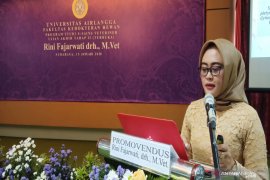Surabaya, E Java (ANTARA) - Rini Fajarwati, drh., M.Vet found the fingerprint data of Alabio duck DNA. The results of her research proved the Alabio duck is a typical duck that is a native germplasm of Indonesia, especially its natural breeding areas in the HSU District, South Kalmantan.
"So, with this evidence of DNA fingerprinting, Alabio ducks cannot be claimed by other regions, especially foreign countries," Rini remarked in Surabaya, Wednesday (Jan 15, 2020).
Her research entitled "Alabio Ducks (Anas platyrhynchos Borneo) Development Strategy Based on the Diversity of CO1 Genes in the Framework of Sustainable Conservation in South Kalimantan" has delivered the State Civil Apparatus (ASN) in the South Kalimantan Plantation and Animal Husbandry Office to obtain a doctorate (S3) of Faculty Veterinary Medicine of Airlangga University, Surabaya, after successfully passing the Final Examination Phase II (Open) Doctoral Study Program of Veterinary Science, Wednesday (Jan 15, 2020).
To ANTARAnews after the dissertation session chaired by the Dean of the Faculty of Veterinary Medicine Prof. Dr. Pudji Srianto, Dr. Mkes, Rini revealed that in the recent time there was a cross-breeding between Alabio ducks and other types of ducks, it was feared that the authenticity of Alabio ducks would become extinct.
She conducted research to find pure lines of Alabio ducks, identified qualitative and quantitative morphological traits, examine their productivity, identify Alabio DNA fingerprints, as Local Genetic Resources (SDGL), and analyze their future development.
Rini began her research with a collection of data, including recording of gender, age and origin of Alabio duck seedlings and the name of the owners.
Next she made observations based on qualitative and quantitative characteristics of Alabio ducks. Qualitative characteristics include the dominant color of the fur in brown with white spots all over the body, eyelashes with white stripes, yellow to orange-yellow beak with black patches on the edges, white front neck feathers, brown back neck feathers, white chest hair, back hair gray spotting brown, shiny greenish blue wing feathers, brown spotting black tail feathers, and orange yellow legs.
While the quantitative characteristics of Alabio ducks include head circumference neck circumference, chest circumference, abdominal circumference, beak length, neck length, body length, right dear length, left wing length, long wing span, right thigh circumference, left thigh circumference, right leg length without claws, the length of the left leg without claws, the length of the right leg with claws, the length of the left leg with claws, measured using a measuring tape in centimeters, and body weight was measured using a digital scale.
Furthermore, productivity research (total egg production, weight per egg, shell thickness, egg yolk quality, and feed conversion) was carried out in the study area, Sungai Pandan Sub-district, HSU.
"The results showed Alabio ducks had a high level of egg productivity, eggshell thickness and good egg yolk quality, as well as efficient feed conversion. While Alabio DNA fingerprints were known for certain by panelists with morphological characteristics and their productivity was continued by DNA analysis with Polymerase Chain Reaction (PCR) and sequencing techniques. The aim is to determine the composition of the Alabio ducks nucleotides as DNA fingerprints," said Rini.
The research results of the woman born in Magetan, 28 September 1981 showed that Alabio ducks are native animals of Indonesia that have a kinship with ducks from North America, Egypt and China.
Then the production of Alabio Duck eggs is also known to be very high at 77.62% using the model of umbaran maintenance (community farms). Alabio ducks have the body's resistance to strategic diseases, especially bird flu from the results of research by a researcher named Yudhi which will also be published.
For this reason, Rini hopes that the Alabio duck is encouraged as a local animal that has the potential to become a global national wealth, both as a natural resource and high productivity livestock as well as a national and global food source, through efforts to recognize science and fulfill the principle of legality.
"Alabio ducks need to be endeavored to be managed with modern management principles as livestock production that can be accepted nationally and globally and can improve the welfare of the people of South Kalimantan and the people of Indonesia as a whole," she concluded.
Rini was given a S3 study assignment, which the scholarship was given by the South Kalimantan Provincial Government. The results of the A value of the dissertation with a promoter Prof. Dr. Sarmanu and co-promoter Prof. Dr. Chairul A. Nidom, became the sweet fruit of her struggle for four years of education for the highest academic degree.
Read also: R&D researches Alabio duck processed products
Read also: Livestock Agency develops Alabio ducks in World Food Day area










